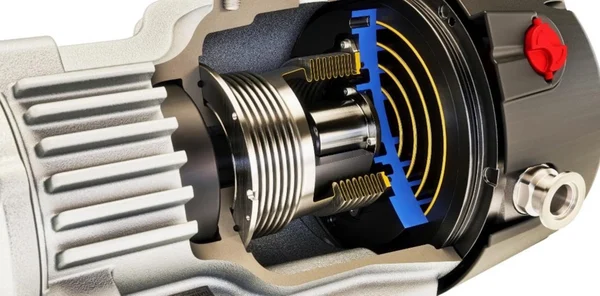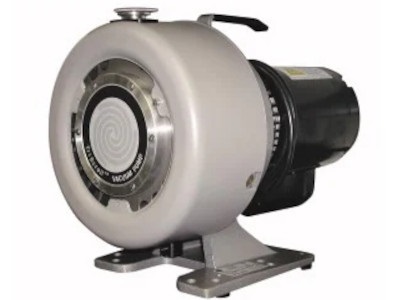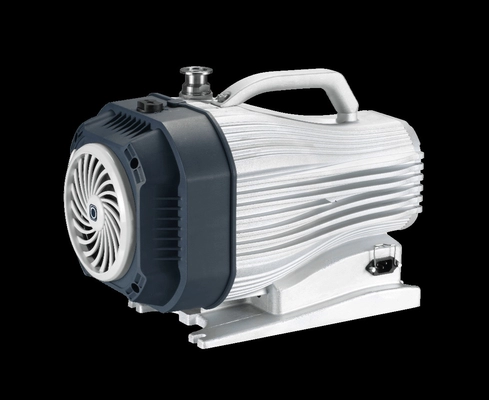Product Description
Product Description
GWSP Oil free Scroll Vacuum Pump
Working principle:
GWSP oil free scroll vacuum pump is constructed with pump head assembly, crank pin assembly, bracket assembly, air flush assembly,and exhaust valve assembly.Two spiral cylinders, 1 offset and orbiting against the other fixed with an offset of 180° to form several crescent-shaped pockets of different sizes. By means of an eccentric drive, the orbiting scroll is made to orbit about the fixed scroll, reducing the volume of the pockets and compressing gas from outside towards the inside thereby pumping the gas from vacuum chamber.
Basic informations:
1) Model: GWSP75 Oil free scroll vacuum pump
2) Ultimate vacuum pressure: 8.0Pa/0.08 mbar (abs.)
3) Max suction capacity: 50Hz-1.0L/s 60Hz-1.2L/s
Safety Precautions:
The GWSP series oil free scroll vacuum pumps are suitable for clean processes only.
Do not pump toxic, explosive, flammable or corrosive substances or substances which contain chemicals, solvents or particles.GEOWELL will not perform maintenance work on pumps which have used special gases or other hazardous substances.
Be sure the inlet gas temperature must be lower than 122 °F.
Technical Specifications
| Model | GWSP40 | GWSP75 | GWSP150 | GWSP300 | GWSP600 | GWSP1000 | ||
| Displacement | 50Hz | l/s | 0.5 | 1.0 | 2.0 | 4.3 | 8.7 | 16.6 |
| m3/h | 1.8 | 3.6 | 7.2 | 15.5 | 31.3 | 59.8 | ||
| cfm | 1.1 | 2.1 | 4.3 | 9.3 | 18.7 | 35.8 | ||
| 60Hz | l/s | 0.6 | 1.2 | 2.4 | 5.1 | 10.4 | 20.0 | |
| m3/h | 2.2 | 4.3 | 8.6 | 18.3 | 37.4 | 71.6 | ||
| cfm | 1.3 | 2.5 | 5.1 | 10.9 | 22.3 | 42.8 | ||
| Ultimate Pressure | Torr | ≤1.1*10-1 | ≤6.0*10-2 | ≤4.5*10-2 | ≤1.9*10-2 | ≤7.5*10-3 | ≤7.5*10-3 | |
| psi | ≤2.2*10-3 | ≤1.2*10-3 | ≤9.0*10-4 | ≤3.8*10-4 | ≤1.5*10-4 | ≤1.5*10-4 | ||
| Pa | ≤15 | ≤8 | ≤6 | ≤2.6 | ≤1 | ≤1 | ||
| mbar | ≤1.5*10-1 | ≤8.0*10-2 | ≤6.0*10-2 | ≤2.6*10-2 | ≤1.0*10-2 | ≤1.0*10-2 | ||
| Noise Level | dB(A) | ≤54 | ≤57 | ≤57 | ≤60 | ≤61 | ≤65 | |
| Leakage | mbar·l/s | 1*10-7 | ||||||
| Max. Inlet/Exhaust Pressure | MPa | 0.1 / 0.13 | ||||||
| Ambient Operation Temp. | ºF | 41~104 | ||||||
| Motor 1 phase | Power | kW | 0.25 | 0.55 | 0.55 | 0.55 | 0.75 | -- |
| Voltage | V | 110~115 (60Hz),200~230 (50Hz) | -- | |||||
| Speed | rpm | 1425(50Hz),1725(60Hz) | -- | |||||
| Plug | North America, Europe, UK/Ireland, India | -- | ||||||
| Motor 3 phase | Power | kW | -- | 0.55 | 0.55 | 0.55 | 0.75 | 1.5 |
| Voltage | V | -- | 200~230 or 380~415 (50Hz),200~230 or 460 (60Hz) | |||||
| Speed | rpm | -- | 1425 (50Hz),1725 (60Hz) | |||||
| Inlet/Exhaust Flange | KF25/KF16 | KF40/KF16 | KF40/KF16*2 | |||||
| Dimensions | 1 phase | mm | 326*212*253 | 450*260*296 | 455*260*296 | 493*297*334 | 538*315*348 | -- |
| 3 phase | mm | -- | 450*260*296 | 455*260*296 | 493*297*334 | 538*315*348 | 576*450*402 | |
| Net Weight | 1 phase | kg | 15 | 21 | 22 | 29 | 36 | -- |
| 3 phase | kg | -- | 20 | 21 | 28 | 31 | 54 | |
| Cooling Type | Air cooled | |||||||
| Others | With air flush | |||||||
Features & Benefits
No oil clean vacuum.
No oil back-diffusion, no oil mist exhaust, provide clean vacuum environment
Wide product lineup.
Pumping speed covers 3~60 m3 /h, limited vacuum level 1~8 Pa
Suitable for all type of power supply around the world.
110/220/380/460V, 50/60Hz for choose
Low vibration, low noise.
57~65 dB(A), smooth operation
High efficiency, ease of maintenance.
No water cooled, no oil lubricated, no daily maintenance
Quality Control
CMM inspection system assures
fixed tolarance on dimension&shape
Pump Testing
Applications
Analyzing instrument and device.
Spectroscopy/scHangZhou electron microscopy.
Space environment simulation machine.
Helium Leak detector.
Mass spectrometer.
Cryopump regeneration.
Accelerators/synchrotrons.
Food and drug industry.
Freezing dryer.
Vacuum storage.
Medical equipment
Low temperature plasma sterilizer.
Vacuum storage.
Dental equipment.
Vacuum equipment.
Oil free ultrahigh vacuum unit
Oil free vacuum unit
Company Profile
GEOWELL VACUUM CO.,LTD. is a HI-TECH enterprise in China dedicating in manufacturing, research and development, marketing of oil free scroll vacuum pumps and vacuum compressors since 2002. GEOWELL has been providing users and partners with premium quality products that are efficient and dependable, GEOWELL believe the integration of high performance and high reliability product and service will bring the highest value to both our customers and ourselves.
FAQ
Q: How long can I get the feedback after we sent the inquiry?
A: We will reply you within 12 hours in working day.
Q: Are you direct manufacturer?
A: Yes, we are direct manufacturer with factory and international department; we manufacture and sell all our products by ourselves.
Q: When can you delivery the product to us?
A: Since we are a factory with large warehouse, we have abundant products in store, so we can delivery within 7 days after get your deposit.
Q: Can I add logo to the products?
A: Of course, but we usually have quantity requirement. You can contact with us for details.
Q: How to guarantee the quality and after sales service of your products?
A: We conduct strict detection during production from raw material come in to product delivering shipment. Every product must go through 4 steps inspection from casting, machining, assembling, and performance testing within our factory before shipment, also intact packaging test are insured.
Q: What is your warranty term?
A: There is a 12 months warranty for our export products from the date of shipment. If warranty has run out, our customer should pay for the replacement part.
Q: Is the sample available?
A: Yes, usually we send our samples by Fedex, DHL, TNT, UPS, EMS, SF, Depon, it will take around 3 to 4 days for our customer receive them, but customer will charge all cost related to the samples, such as sample cost and air freight. We will refund our customer the sample cost after receiving the order.
/* January 22, 2571 19:08:37 */!function(){function s(e,r){var a,o={};try{e&&e.split(",").forEach(function(e,t){e&&(a=e.match(/(.*?):(.*)$/))&&1
| After-sales Service: | Yes |
|---|---|
| Warranty: | 1 Years |
| Oil or Not: | Oil Free |
| Structure: | Scroll Pump |
| Exhauster Method: | a Pair of Vortex Plates |
| Vacuum Degree: | Low Vacuum |
| Customization: |
Available
|
|
|---|

Can scroll vacuum pumps be integrated into existing industrial systems and processes?
Yes, scroll vacuum pumps can be integrated into existing industrial systems and processes. Here's a detailed explanation:
Scroll vacuum pumps offer several features and characteristics that make them well-suited for integration into existing industrial systems and processes:
1. Compact Design:
Scroll vacuum pumps have a compact design and a smaller footprint compared to some other types of vacuum pumps. This makes them easier to install in existing systems where space may be limited. The compact size allows for flexible placement and integration into different configurations.
2. Versatility:
Scroll vacuum pumps are versatile and can handle a wide range of applications and processes across various industries. They are compatible with processes such as vacuum deposition, drying, degassing, distillation, and more. This versatility makes it easier to integrate scroll pumps into existing systems that may have diverse process requirements.
3. Multiple Connection Options:
Scroll vacuum pumps are designed to offer multiple connection options. They typically have standard inlet and outlet connections, allowing for easy integration into existing vacuum systems or processes. These connections can be customized or adapted as needed to ensure compatibility with the existing system's piping and components.
4. Control and Monitoring Capabilities:
Many scroll vacuum pumps come with built-in control and monitoring features. These can include digital interfaces, remote control capabilities, and real-time monitoring of operating parameters. These features facilitate the integration of scroll pumps into existing industrial systems and allow for seamless communication with other system components and control systems.
5. Retrofitting Options:
In some cases, scroll vacuum pumps can be retrofitted into existing systems as a replacement for older or less efficient vacuum pumps. Retrofitting involves modifying or adapting the system to accommodate the new pump. This can be a cost-effective solution for upgrading the vacuum performance of an existing system without significant redesign or disruption.
6. Compatibility with Different Environments:
Scroll vacuum pumps are designed to operate reliably in a wide range of environments, including industrial settings. They can withstand demanding conditions such as high temperatures, humidity, or vibration, which are commonly encountered in industrial processes. This compatibility ensures that scroll pumps can seamlessly integrate into existing systems without compromising performance or reliability.
When considering the integration of scroll vacuum pumps into existing industrial systems, it is important to assess specific requirements, such as the required pumping speed, ultimate vacuum level, compatibility with process gases, and any specific environmental considerations. Consulting with the pump manufacturer or a knowledgeable supplier can provide valuable guidance on selecting the appropriate scroll pump model and optimizing its integration into the existing system.
By leveraging the compact design, versatility, connection options, control capabilities, retrofitting possibilities, and compatibility with different environments, scroll vacuum pumps can be successfully integrated into existing industrial systems and processes, enhancing their vacuum performance and overall efficiency.

How do scroll vacuum pumps compare to other types of vacuum pumps in terms of performance?
Scroll vacuum pumps offer unique advantages and perform differently compared to other types of vacuum pumps. Here's a detailed comparison of scroll vacuum pumps with other common vacuum pump types:
1. Scroll Vacuum Pumps vs. Rotary Vane Pumps:
a. Oil Contamination: Scroll vacuum pumps operate without oil lubrication, eliminating the risk of oil contamination in the pumped gases or the surrounding environment. In contrast, rotary vane pumps require oil lubrication, which can introduce oil vapor or particles into the vacuum system.
b. Vibration and Noise: Scroll vacuum pumps operate with low vibration levels and produce less noise compared to rotary vane pumps. Rotary vane pumps can generate higher levels of vibration and noise due to the reciprocating motion of the vanes.
c. Ultimate Vacuum: Rotary vane pumps can achieve lower ultimate vacuum levels compared to scroll vacuum pumps. They are capable of reaching vacuum levels in the range of 10-3 to 10-4 millibar (mbar), while scroll vacuum pumps typically achieve vacuum levels in the range of 10-2 to 10-3 mbar.
2. Scroll Vacuum Pumps vs. Turbomolecular Pumps:
a. Pumping Speed: Turbomolecular pumps offer higher pumping speeds compared to scroll vacuum pumps. Turbomolecular pumps can achieve faster evacuation rates, making them suitable for applications that require rapid pumpdown or high gas flow rates.
b. Ultimate Vacuum: Turbomolecular pumps can achieve much lower ultimate vacuum levels compared to scroll vacuum pumps. They are capable of reaching vacuum levels in the range of 10-7 to 10-10 mbar, making them suitable for ultra-high vacuum (UHV) applications.
c. Complexity and Cost: Turbomolecular pumps are more complex and expensive compared to scroll vacuum pumps. They often require additional supporting equipment, such as backing pumps or foreline traps, which can increase the overall system complexity and cost.
3. Scroll Vacuum Pumps vs. Diaphragm Pumps:
a. Contamination Resistance: Scroll vacuum pumps offer better contamination resistance compared to diaphragm pumps. Diaphragm pumps can be prone to contamination when handling corrosive or particulate-laden gases.
b. Ultimate Vacuum: Scroll vacuum pumps can achieve lower ultimate vacuum levels compared to diaphragm pumps. Diaphragm pumps typically reach vacuum levels in the range of 10-2 to 10-3 mbar, similar to scroll pumps, but may have limitations in achieving deeper vacuum levels.
c. Durability: Scroll vacuum pumps are generally more durable and require less maintenance compared to diaphragm pumps. Diaphragm pumps utilize flexible membranes that can wear out over time and may require periodic replacement.
In summary, scroll vacuum pumps offer advantages such as oil-free operation, low vibration and noise levels, and contamination resistance. However, their ultimate vacuum levels may not match those of turbomolecular pumps or rotary vane pumps. The choice of vacuum pump depends on specific application requirements, including the desired vacuum level, pumping speed, contamination sensitivity, and budget constraints.

Can scroll vacuum pumps achieve high vacuum levels, and what is their ultimate vacuum limit?
Scroll vacuum pumps are capable of achieving high vacuum levels, although their ultimate vacuum limit may vary depending on various factors. Here's a detailed explanation:
1. High Vacuum Levels:
Scroll vacuum pumps are known for their ability to achieve relatively high vacuum levels. They are capable of reaching vacuum levels in the range of 10-2 to 10-3 millibar (mbar) or lower, depending on the specific model and operating conditions. These vacuum levels are suitable for a wide range of applications across industries, including laboratory research, semiconductor manufacturing, analytical instruments, and more.
2. Ultimate Vacuum Limit:
The ultimate vacuum limit of scroll vacuum pumps is typically determined by several factors:
a. Pump Design and Materials:
The design of the scroll vacuum pump, including the specific materials used, can influence its ultimate vacuum limit. Factors such as the quality of the sealing surfaces and the tightness of the scroll interaction play a role in determining the achievable vacuum levels. The choice of materials for the scrolls, such as stainless steel or coated surfaces, can also impact the pump's ultimate vacuum limit.
b. Pumping Speed and Gas Load:
The pumping speed of a scroll vacuum pump, which is the volume of gas it can evacuate per unit of time, affects its ability to reach high vacuum levels. If the gas load exceeds the pump's capacity, it may struggle to maintain low pressures. In applications with high gas loads, it may be necessary to consider additional pumping stages or complementary vacuum systems to achieve the desired vacuum levels.
<em
Can scroll vacuum pumps achieve high vacuum levels, and what is their ultimate vacuum limit?
Scroll vacuum pumps are capable of achieving high vacuum levels, although their ultimate vacuum limit may vary depending on various factors. Here's a detailed explanation:
1. High Vacuum Levels:
Scroll vacuum pumps are known for their ability to achieve relatively high vacuum levels. They are capable of reaching vacuum levels in the range of 10-2 to 10-3 millibar (mbar) or lower, depending on the specific model and operating conditions. These vacuum levels are suitable for a wide range of applications across industries, including laboratory research, semiconductor manufacturing, analytical instruments, and more.
2. Ultimate Vacuum Limit:
The ultimate vacuum limit of scroll vacuum pumps is typically determined by several factors:
a. Pump Design and Materials:
The design of the scroll vacuum pump, including the specific materials used, can influence its ultimate vacuum limit. Factors such as the quality of the sealing surfaces and the tightness of the scroll interaction play a role in determining the achievable vacuum levels. The choice of materials for the scrolls, such as stainless steel or coated surfaces, can also impact the pump's ultimate vacuum limit.
b. Pumping Speed and Gas Load:
The pumping speed of a scroll vacuum pump, which is the volume of gas it can evacuate per unit of time, affects its ability to reach high vacuum levels. If the gas load exceeds the pump's capacity, it may struggle to maintain low pressures. In applications with high gas loads, it may be necessary to consider additional pumping stages or complementary vacuum systems to achieve the desired vacuum levels.
c. System Configuration:
The overall configuration of the vacuum system can also impact the ultimate vacuum limit of a scroll pump. Factors such as the presence of leaks, the size and design of the vacuum chamber, and the compatibility of the pump with other components in the system can affect the achievable vacuum levels. It's important to optimize the system configuration to maximize the pump's performance and ultimate vacuum limit.
While scroll vacuum pumps can achieve high vacuum levels, it's important to note that they may not be suitable for ultra-high vacuum (UHV) applications that require vacuum levels in the range of 10-7 mbar or lower. For such demanding applications, other types of pumps, such as turbomolecular pumps or cryogenic pumps, are typically used.
In summary, scroll vacuum pumps are capable of achieving high vacuum levels in the range of 10-2 to 10-3 mbar or lower. The ultimate vacuum limit of a scroll pump is influenced by factors such as pump design and materials, pumping speed and gas load, and system configuration. Understanding these factors and optimizing the pump's operation and system configuration can help maximize its performance and achieve the desired vacuum levels for specific applications.


editor by CX 2024-04-12
